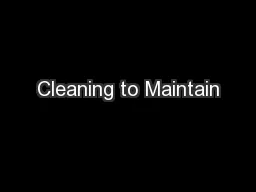

a Healthy Home Steps to a Healthy Home Series Educational programs of the Texas AampM AgriLife Extension Service are open to all people without regard to race color sex disability religion age or national origin ID: 267876
Download Presentation The PPT/PDF document "Cleaning to Maintain" is the property of its rightful owner. Permission is granted to download and print the materials on this web site for personal, non-commercial use only, and to display it on your personal computer provided you do not modify the materials and that you retain all copyright notices contained in the materials. By downloading content from our website, you accept the terms of this agreement.
Slide1
Cleaning to Maintain a Healthy Home
Steps to a Healthy Home Series
Educational programs of the Texas A&M AgriLife Extension Service are open to all people without regard to race, color, sex, disability, religion, age, or national origin.The Texas A&M University System, U.S. Department of Agriculture, and the County Commissioners Courts of Texas CooperatingSlide2
Cleaning
Regular housecleaning C it’s essential to good health.Regular cleaning of surfaces in the home removes dirt and food particles on which pollutants can grow.
Slide3
Household Pollutants to Control
Germs, bacteriaAnimal hair and danderDust mitesPollen
Mold and mildewPests (cockroaches, ants, mice, etc.)Slide4
Reasons to Clean
Germs can be transferred from inanimate surfaces to hands and vice-versa. Some germs can live on dry surfaces (such as toys) for several hours and moist surfaces (like bathroom sinks) for up to three days.
Salmonella can survive freezing and can survive on dry surfaces for at least 24 hours. The average kitchen dishcloth can contain 4 billion living germs.Cockroach and dust mite droppings cause asthma attacks in some people.
Mold can cause allergic reactions or trigger asthma attacks.Slide5
Cleaning for a Healthier Home
Clean and disinfected surface areas are a key to a healthy home.
Household cleaning products that contain an active antibacterial or antimicrobial ingredient provide extra protection against pollutants, including those that may cause disease. Slide6
Cleaning Products
Disinfectants and disinfectant cleaners are the only products that kill germsHousehold cleaning products intended to kill germs on inanimate surfaces must carry an EPA registration number on their label.Slide7
Getting Started – Make a Plan
Clean kitchen dailyClean bedrooms weeklyClean bathrooms 1-2 times a week
Vacuum & dust at least once a weekControl clutter dailyDiscard quarterlySlide8
Cleaning Plan
Break your cleaning into small tasks. Spread it out over several days instead of doing it all at once.
Involve all family members in the cleaning.Clean one room at a time.Slide9
Make a Plan for Cleaning in Each Room
Clean out clutterClean from top to bottomSweep
DustVacuumSlide10
Cleaning Product Labels
Read the label.Follow the instructions.Different products have
different instructions.Slide11
Kitchen
Clean up food spills, crumbs, and liquids on countertops and floors immediately.
Empty trash daily; clean and disinfect weekly.Clean food and grease from the stove daily.Wash and dry dishes as soon as possible after eating (or put in dishwasher).
Wash floors weekly.Slide12
Kitchen
Keep the refrigerator clean and disinfected.Clean the outside and inside of the refrigerator.Clean the drip pan monthly.Slide13
Bathroom
Keep shower doors and curtains open after use to allow air circulation.Shake water from curtains, and squeegee water from the shower walls and door.
Wipe up spills around shower or tub.Use an exhaust fan to remove moisture in the air.Regularly check for and repair leaks.Slide14
Bathroom
Sanitize and disinfect toilets.Wash rugs weekly.Hang towels and wet items to dry, and launder at least weekly.
Sanitize and disinfect sinks weekly.Wash shower curtains.Slide15
Bedroom
Wash bed sheets weekly in hot water, and dry them in a hot dryer.Wash pillows 4 times a year (replace annually).
Wash blankets, comforters, and mattress pads monthly.Vacuum weekly, or damp mop hard- surface floors weekly.Dust furniture weekly.Slide16
Reduce Clutter
Clutter make cleaning more difficult.Clutter creates more surfaces that must be dusted.Clutter causes chaos.Slide17
Tips for Vacuuming
Use vacuum that has a HEPA filter and/or exhaust filter, or use a special bag that holds allergens inside the bag.Vacuum at least once a week – more often if you have a pet.
Empty the canister when it’s half full (or throw it away if it’s disposable).An upright vacuum or a canister with a powered nozzle is best for carpet.A canister vacuum without a powered nozzle is good for cleaning upholstery, draperies, blinds, light dusting, and hard-surface floors.Slide18
Tips on Cleaning Refrigerator
Turn off the controls.Unplug the refrigerator.
Remove the grille, and clean using hand-dishwashing detergent or an all-purpose cleaner.Remove the drip pan – clean and disinfect.Clean mildew on the rubber stripping around the refrigerator door using a solution of 3/4 cup bleach with 1 gallon water (or 3 tablespoons bleach and 1 quart water).Clean the walls and shelves with all-purpose cleaner or a solution of baking soda and water.
Wipe up any water in the inside drawers, and clean them regularly.
Clean up spills immediately, especially raw meat, poultry, and fish juices; use a disinfectant (antibacterial) cleaner.
Slide19
Safety Tips to Follow when Cleaning
Open the windows when using cleaning products.
Don’t leave cleaning buckets where children or pets can get into them. Close caps and spouts, and put cleaning products away right after you use them. Store cleaning products out of the reach of young children and pets and away from food. Keep products in their original containers with their labels on.
Read and follow label directions.Slide20
Cleaning for Health
● Resources – Cleaning for Health Soap and Detergent Association -
http://www.cleaning101.com/health/health/cleaninghealth1.html● New Cleaning Product Trends Soap and Detergent Association – http://www.cleaning101.com/about/news06-27-03.html